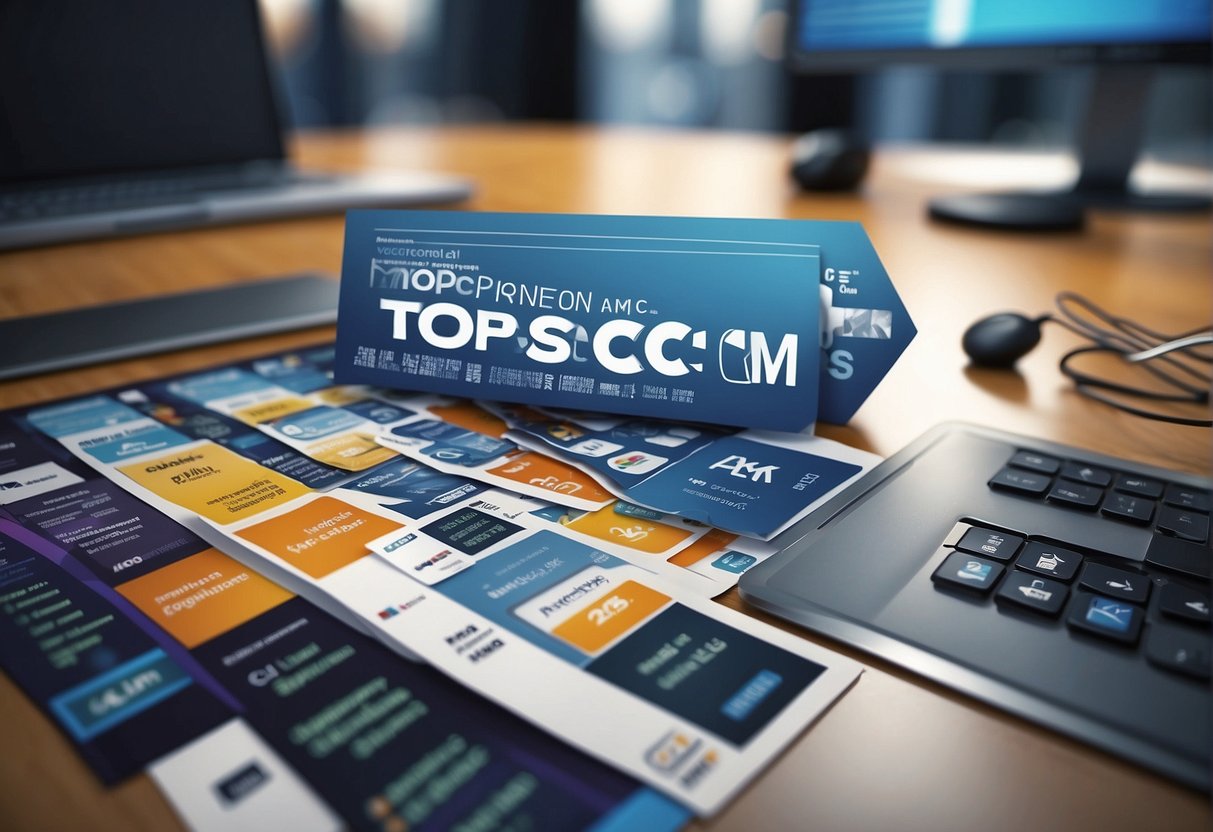How Much Does Supply Chain Management Software Cost in 2024
When you’re looking at supply chain management software, you’re delving into tools designed to streamline your entire supply chain process—from procurement to manufacturing, right down to delivery. This type of management software acts as the backbone for your business logistics, combining several key functions that keep your operations running smoothly.
Supply chain management (SCM) refers to handling the flow of goods and services, which includes all processes that transform raw materials into final products. Software in this domain helps with inventory management, planning, and order fulfillment.
SCM software can significantly improve collaboration across all parts of the supply chain, making it easier to manage purchase orders, ensure timely transportation, and maintain visibility throughout the entire system. You can look forward to:
- Improved inventory planning to prevent shortages
- Streamlined warehouse and order management
- Effective demand planning techniques
With cloud-based SCM solutions, you gain benefits like real-time data access and integrations with other tools. Whether it’s through better coordination of logistics or enhancing transportation management systems (TMS), these platforms are geared towards boosting collaboration and visibility across the supply chain.
Features to look out for include:
- A dashboard for supply chain visibility
- Planning tools for supply chain planning
- Modules specific to procurement and order fulfillment
- Systems for receiving and managing inventory
By leveraging SCM software, you’re capable of not only consistently meeting customer demand but also doing so in a cost-effective and timely manner.
Cost Factors of SCM Software
When you’re in the market for Supply Chain Management (SCM) software, knowing what factors affect the price can be a game-changer for your budget. From initial software licensing to the nuts and bolts of maintenance, these are the costs that will figure into your investment.
Software Licensing Models
Software licenses vary, and so does the pricing. You might encounter a perpetual license, a one-time purchase that can be a hefty upfront cost. Meanwhile, subscription-based models are priced per user per month – like Dynamics 365 Supply Chain Management itching at around $180/user/month. Factor in the number of users, because it’s all about scale.
Customization and Integration Costs
No two businesses are the same, and your SCM software may need tweaking to fit like a glove. Customization can ramp up costs, depending on the complexity. Think of it as tailoring your software suit. And then there’s integration. Slotting your new software into your existing setup, playing nice with other apps and services, even leveraging an API for a seamless blend—this customization stuff isn’t free.
Operational Costs and Support
Running the software comes with its own tab. You’ll want support, maybe even 24/7, and that comes at a premium. Plus, the services to keep the show rolling—think cloud storage or data security—can add to your monthly or annual costs. Imagine it as the fuel in your SCM engine, keep it premium to avoid knocks.
Maintenance and Upgrades
Last but not least, your SCM software isn’t a set-it-and-forget-it deal. Updates and maintenance keep things running smoothly and ensure you’re dodging obsolescence. This could mean regular payments for service plans or fees for big-version upgrades. Like a car, skip on maintenance, and it’s bound to break down.
Types of Supply Chain Management Solutions

When you’re in the market for supply chain management software, you typically encounter three main types of solutions. Each has its considerations, especially regarding data security, and the initial installation process.
Cloud-Based Solutions
Cloud-based solutions are hosted on the vendor’s servers and accessed over the internet. Your data is stored in the cloud, and providers typically handle data security measures. One significant advantage is that you don’t have to worry about the initial installation or ongoing maintenance of hardware.
Pros:
- Quick deployment
- Accessible from anywhere with an internet connection
- Vendor-managed updates and security
Cons:
- Ongoing subscription costs
- Dependence on a reliable internet connection
- Potential concerns over data control
On-Premises Software
With on-premises software, the application is installed directly on your company’s hardware. Your IT team is responsible for maintaining both the software and the associated data security protocols. This can be a more costly upfront investment due to installation and hardware requirements.
Pros:
- Full control over your data
- Customization tailored to specific needs
Cons:
- Higher initial costs for hardware and installation
- Requires in-house IT expertise
- Physical space needed for servers
Hybrid Models
Hybrid models integrate both cloud-based services and on-premises infrastructure. You can store sensitive data on your own servers for added data security while still utilizing the agility of the cloud for other tasks. It’s a balance between control and convenience.
Pros:
- Flexible data storage options
- Scalable to shifting business needs
Cons:
- Can be more complex to setup and manage
- Potentially higher costs due to running dual systems
Key Features to Consider

When you’re eyeing up supply chain management software, your money should be buying you a set of seriously helpful features. Let’s run through some big ones:
- Inventory Management: You want your shelves stocked just right – not too much, not too little. A solid system lets you keep track of your inventory like a hawk and can even give you the heads up for when to restock.
- Forecasting: Look for software with a crystal ball vibe. Good forecasting tools use your data to predict future sales, so you can plan like a pro.
- Order Fulfillment: Getting your customer their goodies on time can make or break your rep. Seek out software that streamlines this whole dance, from the moment an order pops up to the second it lands on a doorstep.
- Procurement: Bargain-hunting for your biz? Get software that helps you nail down the best deals when stocking up on your essentials.
- Vendor Management: Juggling vendors shouldn’t feel like a circus act. Powerful software can keep your vendor relationships smooth and coordinated.
- Warehouse Management: If your warehouse is chaos, find software that’s like a GPS inside – helping you track where everything’s stashed.
Here’s a little table to sum it up, because who doesn’t love a good visual?
| Feature Category | Why It’s Handy |
|---|---|
| Inventory Management | Avoid over/understocking, save cash |
| Forecasting | Prep for demand, keep sales humming |
| Order Fulfillment | Happy customers, swift deliveries |
| Procurement | Buy smart, manage spending |
| Vendor Management | Harmonious supplier relationships |
| Warehouse Management | Find stuff fast, no mess |
Remember, the right features for you depend on what your business needs most – so shop with those needs as your North Star.
Benefits and ROI
When you invest in supply chain management software, you’re not just buying a tool; you’re unlocking potential for significant returns. Your costs are poised to go down while efficiency shoots up, and here’s how:
Efficiency and Productivity Gains
Streamlining operations: SCM software automates many of the repetitive tasks in your supply chain logistics, freeing up your team to tackle more strategic initiatives. This means you’re getting the most out of your labor investment. For instance, you can expect labor costs savings between 10%-45% by optimizing your workforce needs.
Forecasting and Demand Planning: AI-powered analytics help you predict customer demand, so you can manage your inventory accordingly. This precision in forecasting translates to less waste and more savings.
Improved Visibility and Decision Making
Real-time Tracking: With instant insights into every facet of your supply chain, you can make informed decisions quickly. Supply chain analytics provides a clear view of inventory levels, shipment tracking, and more, all contributing to smarter cost management.
Data-Driven Strategies: Access to accurate and comprehensive data means you can analyze trends and patterns for better planning. This visibility not only helps in cost reduction but also boosts the accuracy of your decisions, which is paramount in today’s fast-paced market.
Enhanced Customer Satisfaction
Speed and Accuracy: SCM software speeds up order processing and ensures that what your customers receive is exactly what they ordered, on time. This level of service naturally leads to higher customer satisfaction.
Intelligent Adjustments: With improved demand forecasting and analysis, you’re always prepped to meet your customers’ needs. Not only can you anticipate demand spikes, but you also minimize the risk of stockouts and delays, keeping your customers content—and coming back for more.
Choosing the Best SCM Software
When you’re in the market for the best supply chain management (SCM) software, key factors like your business size, the need for industry-specific tools, and user satisfaction scores can make or break your decision. Let’s dig into what you should look for.
Business Size and Scalability
Your business might be a bustling startup or a well-established enterprise, but the SCM software you choose needs to grow with you. For small businesses, look for software that offers essential features without overwhelming complexity. Scalability is crucial, so the software must adapt as you expand—this could mean scaling up for high-volume e-commerce or meeting the intricate demands of a growing manufacturing operation.
Industry-Specific Features
Each industry has its quirks, and your SCM software should cater to those needs. For retail, you might prioritize real-time inventory updates, while in manufacturing, shop floor management could be the deal-breaker. E-commerce businesses often need strong integration capabilities, so your software should seamlessly click with your online platforms.
User Reviews and Feedback
Before you commit, scour through user reviews and feedback; it’s the closest you’ll get to test-driving the software. Pay attention to comments about user satisfaction, especially from businesses similar to yours. High praise from a variety of sectors, including retail and e-commerce, can be a strong indicator that the software is versatile and user-friendly.
Look for trends in the reviews, too—consistent high scores for customer support or usability are good signs. Conversely, frequent complaints about bugs or clunky interfaces should wave a red flag. Remember, reviews are a goldmine of information, reflecting real-world use beyond the glossy sales pitches.
Top SCM Software Providers

When you’re hunting for supply chain management (SCM) software, it’s like finding the perfect fit for a puzzle. You need the right provider to streamline your operations, whether that’s a robust solution for a massive enterprise, a versatile tool suitable for the mid-market, or a simplified system for your small business.
Enterprise-Level Providers
At the top end, ERP software reigns supreme, with players like Oracle SCM Cloud (NetSuite) that enable you to handle complex, demand-driven networks. They offer a comprehensive suite of applications including procurement, supply chain planning, and logistics. Similarly, powerhouse Manhattan Associates offers scalability and leverages advanced algorithms to optimize supply chain performance across various industries.
- **Oracle SCM Cloud (NetSuite)**
- Comprehensive supply chain functionalities.
- Suitable for complex, large-scale operations.
- **Manhattan Associates**
- Advanced algorithmic optimization.
- Fully scalable for large enterprises.
Mid-Market Solutions
If you’re not running a giant corporation but still need a potent tool, Infoplus or Logility might be your alley. They offer a solid balance of functionality and customization without overwhelming your team. Acumatica comes into play here, too, with a strong focus on resource management and insights into operational efficiency.
- **Infoplus**
- Balance between functionality and ease of use.
- **Logility**
- Focuses on innovative supply chain analytics.
- **Acumatica**
- Resource management and efficiency insights.
Solutions for Small Businesses
For the smaller players, affordability and simplicity are key. You’ll want to peek at Precoro, which streamlines procurement and reduces manual tasks, or Tradogram, known for its expense management features. Freightview throws its hat in the ring for those focused on freight management without the hefty price tag.
- **Precoro**
- Simplifies procurement with automatic workflows.
- **Tradogram**
- Manages expenses and e-procurement effectively.
- **Freightview**
- Specialized in freight management for cost-effectiveness.
Each provider caters to specific needs, and while some variances in pricing and capabilities occur, choosing the right one for you boils down to alignment with your business goals and the size of your operations.
Implementation and Adoption
When you’re diving into the world of supply chain management (SCM) software, remember that the initial purchase price is just the beginning. Following the choice of your software, you’ll need to consider the costs of implementation and adoption.
Implementation involves setting up and configuring the software to work within your organization. It can be as simple as installing on a single server, but for more complex businesses, it might require several servers to handle databases and application processing.
Here’s what you might need for different scales of implementation:
- Small-scale: a single server
- Large-scale: multiple servers (database, application, web server)
The cost of these servers and infrastructure could range from $30,000 to $100,000, depending on size and complexity.
Meanwhile, training is critical to ensure that your team knows how to use the new system effectively. This can include online courses, in-person workshops, or hiring a consultant to guide your staff through the nitty-gritty of the software. Budget some funds for this because a well-trained team is key to a smooth transition.
As for adoption, it’s all about getting your crew on board with the new system. Since change can be tough, it’s worth investing in change management strategies to help your employees embrace the new software. Adoption ties directly into how successfully the SCM software will enhance your operations.
Just remember, a thoughtful implementation and adoption strategy can save you money and headaches down the line. Keep these aspects in mind, and you won’t be blindsided by the costs or the process.
Emerging Trends in SCM Software
In the world of Supply Chain Management (SCM) software, you’re about to see some game-changing trends that’ll make managing your supply chain more efficient than ever. Get ready for an era where AI and advanced data analytics take center stage to help you predict, optimize, and react in real time.
- AI & Machine Learning: These technologies are not just buzzwords; they’re revolutionizing SCM. From forecasting demand to smarter inventory management, you’ll make data-driven decisions like a pro.
- Blockchain: This tech is all about transparency and traceability. You’ll track materials right from the source to the shelf. It’s like having a crystal ball that shows you the life story of your products.
- Internet of Things (IoT): With IoT, everything in your supply chain is connected. Imagine monitoring your shipment conditions in real-time or using sensors that tell you when it’s time to replenish stock.
Here’s what you need to keep an eye on:
| Technology | Impact on SCM |
|---|---|
| AI & Machine Learning | Forecasting and real-time decision making |
| Blockchain | Transparency and security |
| IoT | Connectivity and instant monitoring |
Each trend is shaping up to not just change the way you manage your supply chain, but how agile and responsive it can become. And as these technologies intertwine, your software will give you insights that can help save costs and skyrocket efficiency. Buckle up – your SCM software is about to get a whole lot smarter.
Common Questions about SCM Software Costs
When you’re considering Supply Chain Management (SCM) software, there are some key questions you might have about the costs involved. How much should you expect to pay? What factors into the price?
How much does SCM software cost?
Costs vary widely based on your business size, features needed, and whether the solution is on-premises or cloud-based. You could be looking at anywhere from $120 to $22,000 per year or more. Smaller businesses may find more affordable options, while larger companies may need to invest in more complex, customizable systems.
What factors into the cost of SCM software?
- Number of users: More users typically mean higher costs.
- Customization level: Tailoring the software to your needs can add to the cost.
- Integration complexity: The more complex your systems, the more you might have to pay for integration.
- Support and updates: Ongoing support and regular updates might incur additional fees.
Do I pay for updates?
It depends on the vendor. Some may include updates in their base fee, while others may charge for major upgrades.
Can I get a free trial?
Many vendors offer free trials! It’s a good idea to take advantage of this to see if the software meets your needs.
Remember, the best way to get accurate pricing is to get a quote tailored to your specific needs. Don’t hesitate to reach out to vendors and ask questions to ensure you’re making the best investment for your supply chain.






